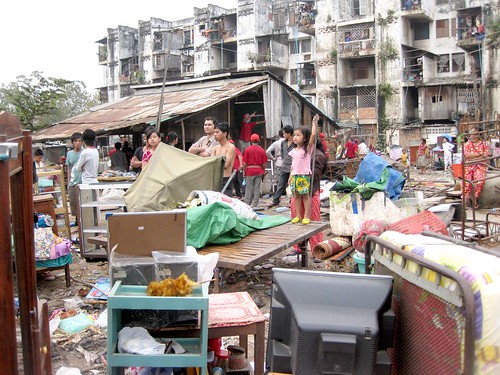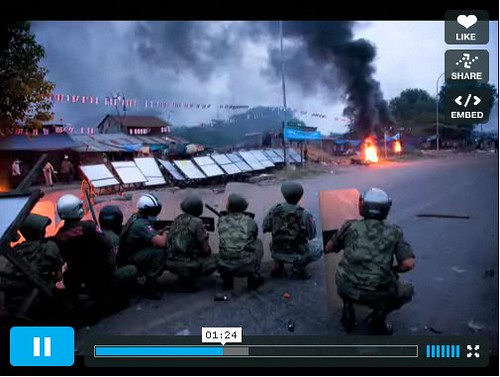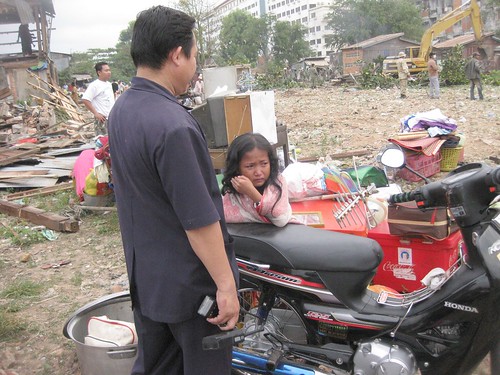Dey Krahom: Slow Motion Replay
Jan 29th, 2009 by Jinja
Looking for the latest info? I’m going to start archiving it here: http://jinja.apsara.org/dey-krahom-info/
Dey Krahom has always been a curious community. Some of my Khmer friends were uncomfortable to go there. Others called it (and the ‘grey building’ towering above it) home. I visited the area frequently in 2003 and 2004, observing the music & theatre classes of Tep Marie, Ieng Sithul and Kung Nei. I also had the good fortune to see the students of Aziza School and the breakdancers of Tiny Toones.
Walking past vendors salting their tiny seashells, one older visitor reminisced: “This is where the helicopters came on the day the US evacuated.”
The same vendors used their aluminum carts as makeshift barricades on the day the police/military police/hired hands/company men came for a different kind of evacuation: the complete destruction of an urban village. By this time, Dey Krahom had been whittled down to a core of determined resisters. They’d just written a song to celebrate after one of their leaders had been released from jail due to a protest-related charge.
At six in the morning there was just enough light and legality to enable the assembled forces to move in. The results are pretty well documented. The village was flattened. The echoes, though, are reverberating in the local and international news, thanks to some volunteers who braved bruises and damaged equipment. I’m thankful there weren’t any deaths, but the story isn’t over yet.
In the ‘developed world’, the conflict would have been seen in real time, complete with citizen-sourced media. For this particular story, a small stream of pictures, blog posts and two videos made it out within the first 24 hours, in addition to three news stories, two of which were text-only. Several days later, more detailed news stories were being filed as more video, audio and blogs started surfacing – showing more evidence of the early morning assault.
Cambodia is full of camera phones, digital cameras, and a growing number of internet service providers. But the story didn’t play out in real time. We didn’t see 7NG release a rebuttal to activist statements on YouTube. We didn’t hear about the National Assembly protest by Twitter feed. No one has yet assembled a list of ‘del.icio.us’ links. Was this a failure of social media? Are people in Cambodia effectively using what could be qualified as ‘social media’?
Several days later, citizen photos, videos and testimonies are slowly coming to light. The issue refuses to go away. But for a day or two there, it looked like it could have faded. I would venture the reason it’s taken so long is more due to ‘social’ aspects than ‘media’ channels and formats.
Specifically: 1. the social fabric of the community, 2. the functioning of civil society institutions, and 3. the ad hoc deployment of media tools.
First, Dey Krahom had internal divisions, and these were played upon to get families to leave until there was finally a group small enough to take on physically. It’s important to note that they were demolished in part by prior evictees, hired from Andong relocation site and other places.
Many inhabitants of the ‘grey building’ felt their property values were influenced by the unplanned nature of the village below. Dey Krahom didn’t have the support of previous evictees, and it didn’t have the support of the next targets. This is worth noting, because the same scenario will repeat itself in the future. Will Dey Krahom villagers find themselves trucked out to Boeung Kak to tear down buildings, for the promise of $5 and a free breakfast?
Secondly, the coalition of NGOs working to get fair compensation for Dey Krahom was composed of numerous groups, all with different institutional cultures. They agreed on the big goals. As for the implementation, they were more like a confederacy than a coalition. This event has brought them (out of necessity) into closer coordination. Most of the media emerging was captured by people who were sleeping in the village on the 24th.
Third, the groups participating in the Coalition On Housing Rights and Evictions were quick to respond — in traditional media. Press Releases were issued immediately, and a critique of local media coverage followed three days later in the local paper of record. The NGOs were less coordinated in their use of new media. Most media was recorded by volunteers, though a TV crew was fortunate enough to be filming that day.
Digital media produces large sized high quality files ready for print and broadcast media. Often they are uploaded ‘as-is’. But Cambodia is a low-bandwidth country. Which meant a painstaking process of selection, editing and optimization had to take place.
Bloggers broke the story first, and the Phnom Penh Post followed the evening of the 24th with photos, an article and a video – courtesy Bridges Across Borders. After that, there was a slowly growing trickle as photographers and filmmakers got their information online.
The de facto online portal for this seems to have been the Cambodia Evictions Update Facebook Group, growing from around 50 to 400 in under a week. The issue deserves a better portal, but this will have to do for now. http://www.facebook.com/group.php?gid=69319195624
A film about Dey Krahom was screened at Meta-House last night. Fortunately this was a private venue, otherwise it would have been a challenge to get administrative approval for the film to be shown. Many on the crowded rooftop asked: “What can I do? Who can I contact?” The same is being asked by international readers. LICADHO texted out a message of thanks this afternoon, having been given many donations of clothes and necessities for the newly homeless villagers.
So as eyes turn to the Grey Building, Boeung Kak, and Group 78, here are a few thoughts for the future:
1. Communities are benefited by having a media strategy. Many are already producing their own media – songs, pictures, short videos – they simply aren’t aware of the full capability of the tools they have.
Smart digital correspondents may be able to scoop the mass media by keeping an eye on emerging issues. Heck, you could make some money off it, at the very least get your name in print for breaking the story. This could be a Cambodian with a cameraphone – or a seasoned overseas correspondent.
2. The internet moves at the speed of light. In Cambodia, it moves at the speed of bureaucracy. Institutions need to be prepared to utilize new media tools or otherwise they are going to be completely dependent on young interns/foreign staff to manage their international internet presence. Barack Obama doesn’t set up his own webcam – but he does make regular use of YouTube. And all those donations he got? Many were small donors giving via the web.
And as institutions make plans for an internet strategy, maybe they can coordinate with the communities and partners they work with. It makes sense not to duplicate efforts. Digital media is cheap media. Use it well and the viewing public is dropped right into the center of the issue.
Will it happen overnight? Unlikely. But when groups see the resources it can muster, yeah. Hmm, that Facebook group is up to four hundred and rising. Have they signed up for your mailing list?
3. Human rights organizations thrive on text messaging. To ensure that there was no confusion during the 2007 election, a text-free ‘tranquility period’ was enforced, which indicates the seriousness with which the establishment views text messaging. I’m surprised no local organization has set up an institutional twitter feed yet. Who will be the first?
And that’s just the start. Web 2.0 still has a ways to go in Cambodia. Are Flickr, Twitter, Del.icio.us, or the word ‘blog’ familiar? They will be. They should be. The communities you work with are already appearing in them, and using them.
Commenting: still wonky. I’ll post them as I get ‘em. Tags: cambodia,evictions,khmer,society

















